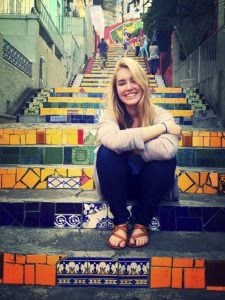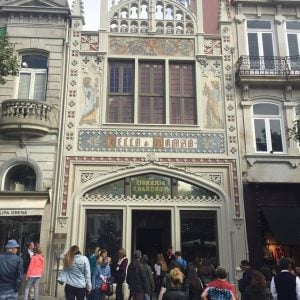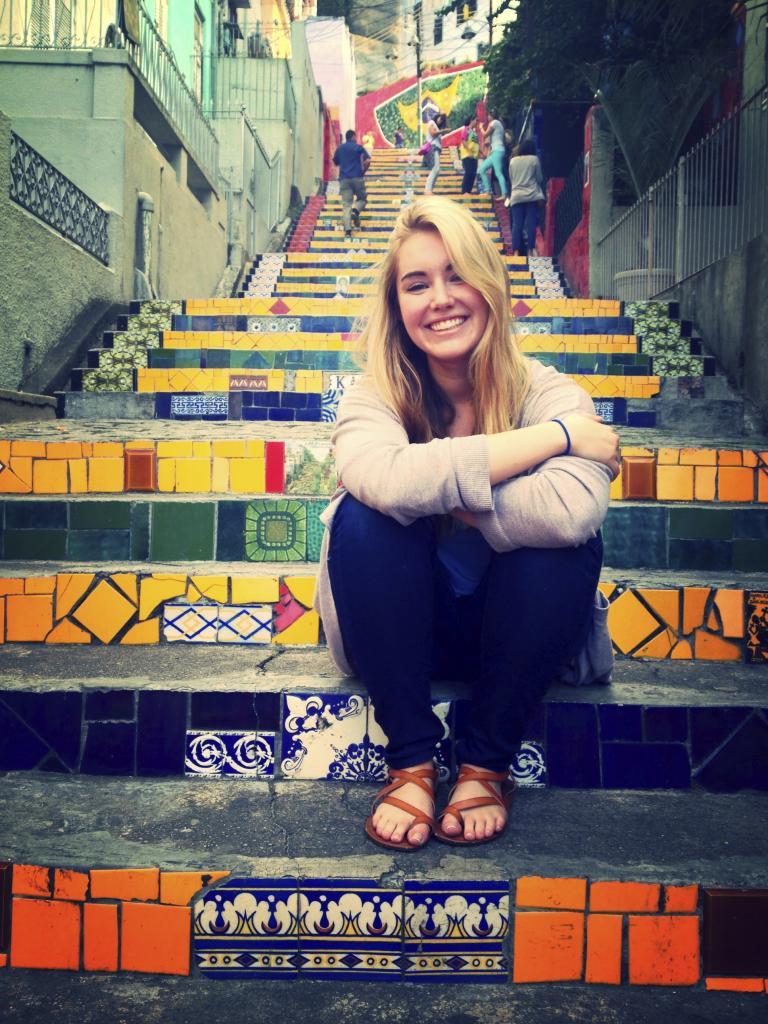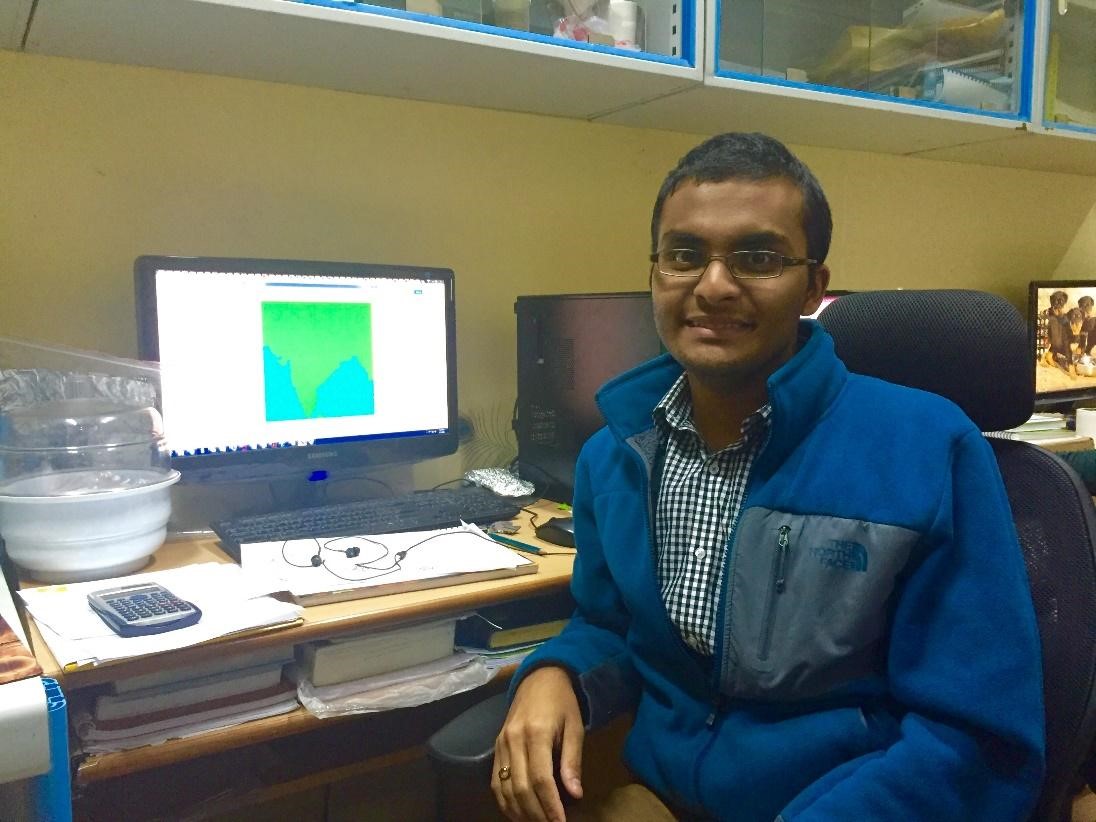
Katie Salgado, 2016-2017, Fulbright English Teaching Assistant to Portugal, sitting on a tiled stoop in Seia
In partnership with Reach the World (RTW), the Fulbright U.S. Student Program is publishing a series of articles written by Fulbright English Teaching Assistants participating in Reach the World’s Traveler correspondents program, which through its interactive website, enriches the curriculum of elementary and secondary classrooms (primarily located in New York City but also nationwide) by connecting them to the experiences of volunteer Fulbright English Teaching Assistants (ETAs) and other world travelers who are currently studying and living abroad.
It was a misty Thursday morning in Seia. I exited the passenger side door of a silver compact car and looked up at the yellow Instituto Politécnico da Guarda (IPG) School of Tourism building. I was with my coworker, Rita, who had asked me to do a presententation to her management students on American culture. This was my first experience teaching English as a Fulbright English Teaching Assistant to a group of students in Portugal, and I was eager to discover what the students knew about American culture and traditions. Rita and I entered the building and prepared the classroom for the day.
By 9:15 a.m., the freshman students shuffled sleepily into the classroom and took their seats. They exchanged confused glances with one another, unsure of whether to speak to me in English or in Portuguese. I stood there in my black blazer and greeted them with “Good morning, everyone.” Rita sat in the back of the classroom and remained there to observe my presentation. Once the last straggler sat down at his desk, Rita smiled and flashed me a thumbs up. It was time to begin.
I introduced myself to the twenty students in the room and began my PowerPoint presentation on where I was from, my academic background and hobbies.
I then clicked to the next slide: an outline of the United States of America with the red, white and blue flag waving in the background.
I turned to the students and asked, “What do you think of when you see this image?”
Suddenly, hands shot up in the air.
“Hot dogs!”
“McDonald’s!”
“American football!”
“Guns!”
As I suspected, McDonald’s and American football were one of the first stereotypes to be discussed.
“Why do you call it ‘football’ if you don’t always hit it with your foot?”
“Does everyone eat fast food in America?”
I did my best to explain to them that not everyone in the United States eats fast food and that American football actually evolved from a mix of rugby and soccer. I showed them photos of the many cities and regions of the United States in order to show them just how diverse American culture can be.
Perhaps one of the most difficult questions I had to answer was: “What is the biggest difference between Portugal and the United States?”
It took me a moment to collect my thoughts.
“From what I have observed,” I began, “the rhythm in Portugal tends to be more laid back than the United States. For example, people here in Portugal may take up to three hours to have lunch with a friend, and are less concerned with being late to their next appointment. On the other hand, Americans tend to be very time conscious. It is completely normal to drink coffee in your car or order a meal ‘to go’ in the U.S., whereas this is rarely done in Portugal. In general, people here tend to sit down to eat a meal or drink a coffee.”
The rest of our discussion covered a variety of topics: Portuguese communities in Massachusetts and Rhode Island, the influence of mass media and pop culture and even exchange programs between the United States and Portugal.

The bookstore in Porto, Portugal that inspired Hogwarts in J.K. Rowling’s Harry Potter
The students were not only curious to learn more about the United States, but they were also eager to share interesting facts about Portuguese culture and history. Did you know that J.K. Rowling lived in Portugal while she was writing her first Harry Potter novel? There are several churches and castles in Portugal that inspired her design of Hogwarts. Moreover, it is a Portuguese tradition for seniors at the university level to dress in all black cloaks. The Hogwarts uniform is based on this tradition. As we discussed the history of our respective countries, I also learned that Portugal abolished slavery fifty years before any other colonial power. How cool is that?
Even though my role in Seia was to be a teacher, I quickly realized that the students had taught me about Portuguese culture and its influence on history as well as contemporary society. Had I never left the United States, I may never have questioned my routine or the pace with which I accomplish things. Had I never lived in Portugal, I may never have learned about J.K. Rowling’s inspirations or the progressive anti-slavery policies of the Portuguese.
I learned that whether you are from the United States, Portugal or elsewhere, it is not our differences that define us, but rather our shared desire to work together and improve life as we know it. As students of the world and Fulbrighters, it is up to us to question what we perceive as “normal” and keep an open mind when talking with others. You never know what you may discover!



No Comments